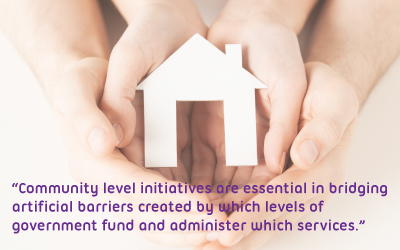Domestic Violence and Homelessness

Dr. Abe Oudshoorn is an Assistant Professor in the Arthur Labatt Family School of Nursing at Western University, as well as the Department of Psychiatry Schulich School of Medicine & Dentistry, Associate Scientist with Lawson Health Research Institute, and a member of the Centre for Research on Health Equity and Social Inclusion. Having worked as a nurse with people experiencing homelessness, Abe’s research focuses on health, homelessness, gender, trauma, housing policy, mental health, and poverty. Outside of the University, Abe is on the Steering Committee of the London Homeless Coalition, is a board member with the United Way of London & Middlesex, and sat on the Mayor’s Advisory Panel on Poverty. Abe is the recipient of Western University’s 2016 Humanitarian Award.
In 2003, Jean Calterone Williams in her text “A Roof Over My Head: Homeless Women and the Shelter Industry” writes:
Women’s stories and comments have shown repeatedly the importance of domestic violence in understanding homelessness. Yet most research distinguishes between women who live in homeless shelters and those in domestic violence shelters. Likewise, the environments and programs the two types of shelters offer vary significantly, based on the idea that battered women need different services than homeless women do.
This dichotomization of women leaving domestic violence and women experiencing homelessness continues 14 years after publication of this text. This is in no small part because of the different orders of government involved in managing services for these women, with the provincial government managing VAW shelters and municipal governments managing emergency/homeless shelters.
However, conversation with those working front lines in these two settings demonstrate that this dichotomy is essentially false. For starters, we need to understand that the Canadian definition of homelessness is not limited to those who are absolutely unsheltered (ie. “sleeping rough”), but also includes being in shelter or provisionally accommodated. Therefore, all women in a VAW shelter are considered homeless at their time of shelter stay, even if they are financially stable and able to return to safe and permanent housing at a later date. Secondly, shifts in demographic trends at VAW shelters has more service being provided to women with multiple or chronic experiences of homelessness, and less for those who are well resourced, stably employed, or with large social support networks. Thirdly, on the emergency shelter side, every study that comes out reifies that the vast majority of women in shelter have experienced intimate-partner violence (see this literature review), even if they are not identifying this as their reason at this time for seeking emergency shelter.

Fortunately, some communities in Ontario have been coming together to bridge the divide between the homeless-serving and the VAW sectors. Hamilton, for example, has a Women’s Housing Planning Collaborative as part of their social planning council. London, more recently, has been bringing together service providers at a table called “Connecting the Dots”, and a 2-day solutions lab on women’s homelessness. These community level initiatives are essential in bridging artificial barriers created by which levels of government fund and administer which services. Hopefully best practices can come from these communities and others, and spread across the province so that women can be better served in finding safe, permanent, affordable housing of choice.
